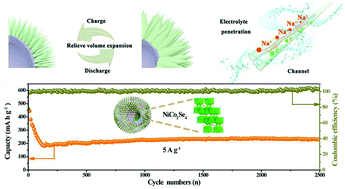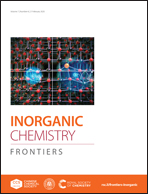Construction of a bimetallic nickel–cobalt selenide pompon used as a superior anode material for high performance sodium storage†
Abstract
Sodium-ion batteries are considered to be one of the most ideal alternatives to lithium-ion batteries as the next generation of advanced batteries due to their wide resource and low-cost advantages. However, it is urgent to find a suitable anode material to fill the gap since the commercial graphite anode cannot be applied to sodium-ion batteries. Bimetallic selenides stand out among multitudinous anode materials on account of their synergistic effects and rich electronic reaction processes. Here, a nickel–cobalt selenide pompon has been successfully prepared via a simple solvothermal method. Pompon-like NiCo2Se4 not only promotes the penetration of the electrolyte but also increases the electron and ion diffusion channels. In addition, this design can effectively alleviate the volume expansion of the material during charging and discharging. More importantly, the synergistic effect of Ni and Co bimetals can greatly enrich the electronic reaction process and improve the conductivity to obtain sufficient sodium-ion storage. When using this material as an anode of sodium-ion batteries, these unique advantages together facilitate NiCo2Se4 to deliver an impressive reversible capacity of 230 mA h g−1 at 5 A g−1 and excellent cycling performance up to 2500 cycles with a capacity decay rate of only 0.019%.



 Please wait while we load your content...
Please wait while we load your content...